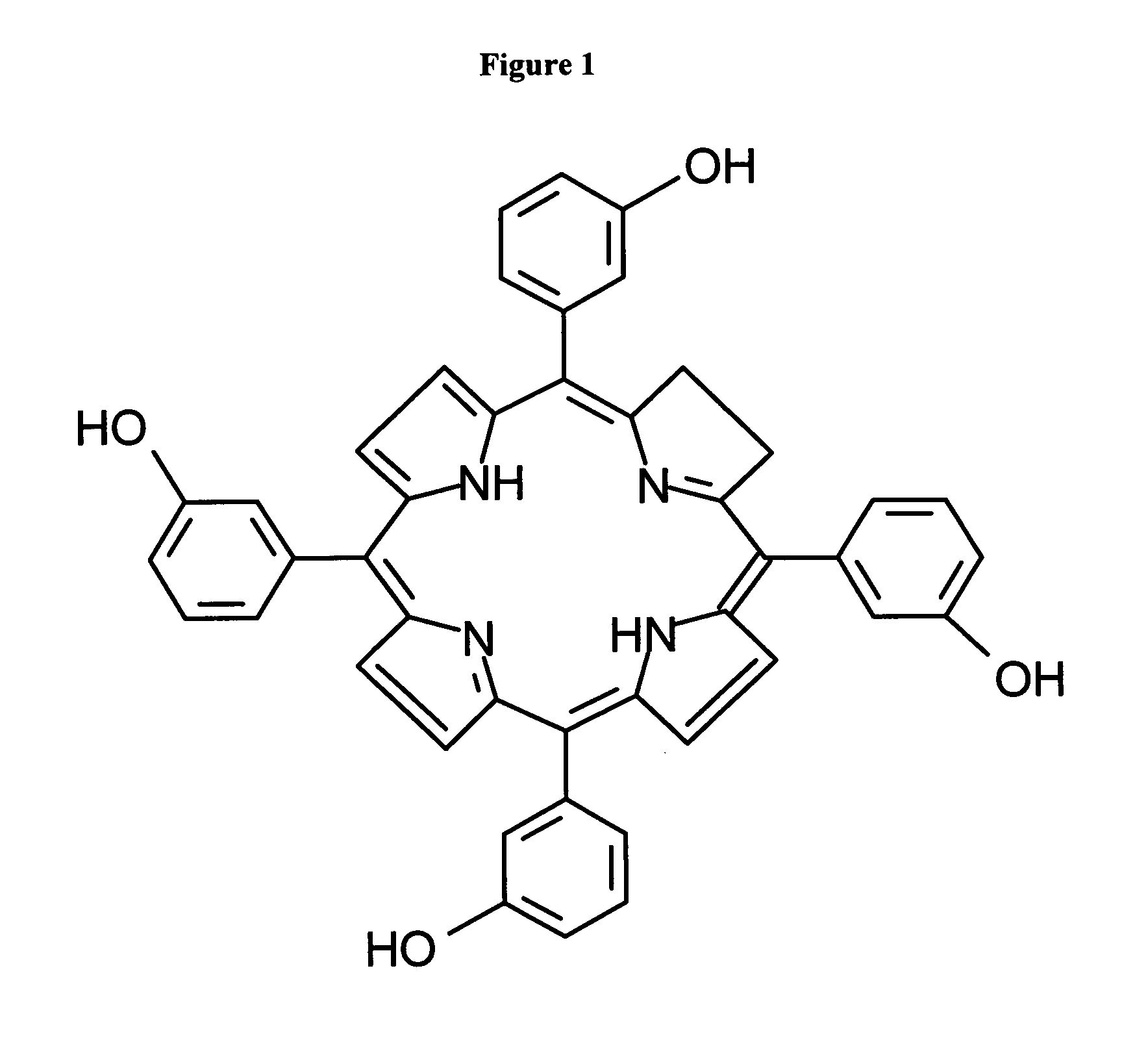Formulations for cosmetic and wound care treatments with photosensitizes as fluorescent markers
a technology of fluorescent markers and cosmetics, applied in the field of fluorescent markers, can solve the problems of mechanical weakness of unprocessed collagen and limit its us
- Summary
- Abstract
- Description
- Claims
- Application Information
AI Technical Summary
Benefits of technology
Problems solved by technology
Method used
Image
Examples
example 1
Uses of Liposomal Temoporfin as Marker with Collagen as Filler for Wrinkle Removal
[0032]A low concentration of liposomal formulated temoporfin (3-5 μg / ml mTHPC) is injected with collagen into a treatment site. The liposome formulation of hydrophobic temoporfin is beneficial as it increases water solubility. After injection the site is illuminated with suitable excitation wavelength, which generally is different from the photosensitizer's main absorption peak, thus avoiding cytotoxic damages to cells. For temoporfin (mTHPC) its spectrum has an excitation maximum at 417 nm while the main absorption peak is at 652 nm. The photosensitizer used here serves as a visual marker indicating the success of injected collagen material.
example 2
Uses of Temoporfin as Marker to Study the Photochemical Cross-Linking of Collagen
[0033]To trace the photochemical cross-linking of collagen using photoactive compound a small amount of liposomal formulation containing a low concentration (3-15 μg / ml) of temoporfin (mTHPC) is used with collagen. In this case temoporfin is used as marker as well as photo therapeutic compound. The spectral character of temoporfin shows excitation maxima at 417 nm and an activating peak at 652 nm. Photochemical cross-linking of the collagen can be followed by monitoring the fluorescence of temoporfin excited by 417 nm.
Pepsin Promoted Collagen Gel Degradation Study Using Temoporfin Marker Material:
[0034]3 batches of collagen gels, collagen content 9.37 mg / ml Collagen I rat tail (2 test plates containing 4 samples)
TABLE 1Collagen Gel Batch FormulationIrradiation 652 nmbatchConsistencemTHPC (μg / ml)(J / cm2)1Gel0102Gel5103Gel5—
[0035]Batches 1, 2 and 3 are prepared, each containing a 15 ml solution of commerc...
example 3
Uses of Temoporfin as Marker with Hyaluronic Acid as Dermal Filler
[0038]Medical devices composed of hyaluronic acid and liposomal formulated mTHPC are used as dermal fillers. In an example, 1 ml (20 mg / ml injecting solution) of hyaluronic acid is mixed with a liposomal formulated temoporfin, wherein, temoporfin is present in a low concentration (3-10 μg / ml ) for tracking the hyaluronic acid in vivo. This formulation is water soluble and is further diluted with water to get the final injecting solution. After injecting the formulation having hyaluronic acid with a liposomal formulated temoporfin, the site is illuminated with suitable excitation wavelength which is not generally identical with main absorption (activation) peak of the temoporfin, thus avoiding cytotoxic damages to cells. The injected site may also be covered with a light blocking plaster or plastic to protect the skin area from phototoxic effect of light exposure for few days. The light was incident uniformly over the ...
PUM
| Property | Measurement | Unit |
|---|---|---|
| concentration | aaaaa | aaaaa |
| concentration | aaaaa | aaaaa |
| concentration | aaaaa | aaaaa |
Abstract
Description
Claims
Application Information
 Login to View More
Login to View More - R&D
- Intellectual Property
- Life Sciences
- Materials
- Tech Scout
- Unparalleled Data Quality
- Higher Quality Content
- 60% Fewer Hallucinations
Browse by: Latest US Patents, China's latest patents, Technical Efficacy Thesaurus, Application Domain, Technology Topic, Popular Technical Reports.
© 2025 PatSnap. All rights reserved.Legal|Privacy policy|Modern Slavery Act Transparency Statement|Sitemap|About US| Contact US: help@patsnap.com


